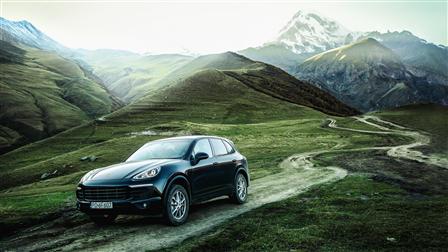
The Cayenne Explores the Caucasus
The solitude of the mountains forms a backdrop both magnificent and austere for the high-tech
From Turkey through Georgia to Azerbaijan: The new
The Georgian border guard checks our documents, rocking back and forth on his chair as he enters something into his computer. He glances from the screen to our car and back again. Something doesn’t seem right. We have to get out of the car and hand him our passports in his booth, which gives us the opportunity to peek over his shoulder. His screen shows a drop-down list of cars that have to be registered on entering the country:
But we are traveling in a new
Our trip starts that morning in the Turkish city of Trabzon on the shore of the Black Sea. As we drive to a stunning remnant of medieval glory—the Sumela Monastery around 50 kilometers to the south—the villages become sparser, and the road and valley ever more narrow. A winding mountain road then follows, on which the
![[+]](https://staging.www.porsche.com/filestore/image/multimedia/none/rd-2015-christophorus-issue370-article04-content-01/normal/d15d0593-aded-11e4-b849-001a64c55f5c/porsche-normal.jpg)
The Sumela Monastery is chiseled into the cliffs of the Altindere National Park in Turkey.
The sun rises over the Georgian city of Batumi on the Black Sea.
Despite its overwhelming exterior appearance, the inner courtyard has a peaceful atmosphere. In quiet moments we can hear water dripping, as it has for ages, from the cliff into a specially built tank. Signs on both sides of the stairs indicate the way to the kitchen, bakery, and library. The signs have evidently been there since medieval times to show the monks the way to their bread and their books. The Ottoman sultans cannot be thanked enough for protecting the monastery. They allowed Greek Orthodox monks to live and work in Sumela for centuries. Beautiful frescoes covering the inside and outside of the stone church speak of times long past. Still impressed by their richness of color, we head back on the same road from Trabzon, then head up the coast to Georgia.
Hardly have we crossed the border in the evening twilight when a herd of cows right past the first curve prompts us to slam on the brakes. Utterly unimpressed by the
Iron Age monuments: Alphabet Tower and the Ferris wheel in Batumi.
The next morning we depart for Tbilisi as the rising sun illuminates Georgia in all its glory. From Batumi in the autonomous republic of Ajaria we first head north, then northeast toward Kutaisi and then to the east. We decide to take a shortcut south in order to put the new
The further we drive into the countryside, the worse the roads become. They start off well paved, then we see a few potholes here and there, and suddenly we’re on a bumpy gravel road which soon begins climbing and winding its way through the Meskheti mountain range. The midday sunlight brings out the full intensity of color on its gentle tree-lined slopes. A gorgeous view—and a gorgeous start. The
![[+]](https://staging.www.porsche.com/filestore/image/multimedia/none/rd-2015-christophorus-issue370-article04-content-02/normal/c4c0d52f-adee-11e4-b849-001a64c55f5c/porsche-normal.jpg)
Time seems to have stood still in some of the mountain villages in Georgia.
Horses and cows are constant companions in Georgia.
The following day takes us up into the Caucasus Mountains. The S3 highway, better known as the Georgian Military Road, starts north of Tbilisi. Its name derives from the fact that the Russians built it in the nineteenth century in order to consolidate their hold on the recently conquered Caucasus region. Despite constant renovation, its broken surface and frequent gravel segments make it look like time came to a standstill after construction. But the landscape more than compensates. For example, the Zhinvali reservoir, a giant V, with the Ananuri castle rising above its turquoise waters, as if in a fairy tale. We drive through the picturesque Aragvi river valley, surrounded by an ever higher succession of peaks. On the eastern side of the valley, after a series of sharp switchbacks seemingly designed to show off the
Peter Jackson could just have well filmed The Lord of the Rings here. This entrancing village lies in the midst of sharp ridges that look remarkably like the Misty Mountains in the famous trilogy. Above it all towers the massive snowy summit of the dormant Kazbek volcano, with the Trinity Church perching on a nearby hill. Reaching the church becomes a highlight in itself, as it entails the obstacle course of a narrow, muddy, and deeply rutted track. For what is normally a three-hour hike, our
Still another 700 kilometers to Baku, on the edge of the Caspian Sea. We turn off the military road to the east. Countless trucks on the bumpy stretch up to the pass raise clouds of dust that make it impossible to see almost anything. As the road descends the dust disperses and we gaze down the steep slope onto the immense plain of the province of Kakheti. The chill of the Caucasus has given way to a nearly shimmering heat. A perfect climate for grapes—with one vineyard after the other. It is no coincidence that wines from this area are well known worldwide.
Soon thereafter we reach the border of Azerbaijan, where we exchange questioning glances on spotting the sign that reads “Good luck.” Like in a James Bond movie or a John le Carré novel, we are required to get out of our cars and walk over the bridge to cross the border. The formalities take about an hour, and then we’re in Azerbaijan, welcomed by its flag fluttering in the south wind.
Despite some similarities with Georgia, this country is far more prosperous—it is oil-rich. Slowly but surely we approach Baku as darkness lowers an impenetrable veil over the countryside. It is late in the evening when our
By Mikołaj Kirschke
Photos by Gary Parravani, Jonathan Hatfield
![[+]](https://staging.www.porsche.com/filestore/image/multimedia/none/rd-2015-christophorus-issue370-article04-margin-01/normal/48d47d9f-adef-11e4-b849-001a64c55f5c/porsche-normal.jpg)
![[+]](https://staging.www.porsche.com/filestore/image/multimedia/none/rd-2015-christophorus-issue370-article04-margin-02/normal/dd519c83-adef-11e4-b849-001a64c55f5c/porsche-normal.jpg)
![[+]](https://staging.www.porsche.com/filestore/image/multimedia/none/rd-2015-christophorus-issue370-article04-margin-03/normal/e3d3e9f4-adef-11e4-b849-001a64c55f5c/porsche-normal.jpg)
![[+]](https://staging.www.porsche.com/filestore/image/multimedia/none/rd-2015-christophorus-issue370-article04-margin-04/normal/3b34d5a7-adf0-11e4-b849-001a64c55f5c/porsche-normal.jpg)











